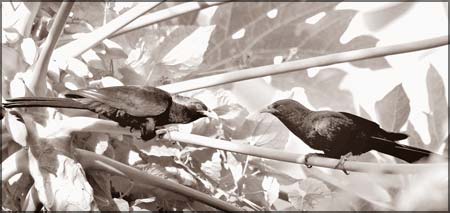This strange bird - Koel
K.G.H. Munidasa
No readers who are resident in rural areas, can fail to notice that
round about the end of March and early April the first bird to greet the
dawning day is the Koel or 'Avurudu Koha', as it is popularly called.
Anytime between 4 a.m. and 5 a.m. it begins its 'Sunrise Song', which is
immediately picked up by a chorus of koels in the neighbourhood. After
the sun has risen in the heavens, the koel reaches its crescendo.
A couple of months before one hardly saw a Koel, but now they are
everywhere, flying about in pairs and often with crows in hot pursuit.
Racial custom
|

Koel or ‘Gomara Koha’ belongs to Cuculiformes or Cuckoos.
Picture by Saman Sri Wedage |
While this sudden vivacity is magical enough to be felt by all, it is
doubtful whether five persons in a hundred would ever stop to fathom
what brings this about and why.
The Koel or 'Gomara Koha' belongs to the order of birds called
Cuculiformes or Cuckoos.
Delegating their parental duties to other birds is a racial custom
prevalent among all true cuckoos.
Hence, their breeding seasons are always determined by the relevant
host species.
Thus in Sri Lanka the nesting period of the Koel coincides with that
of the House Crow and the Black Crow, which falls annually between the
months of April and August. The Koel's incessant calling around the
Sinhala and Tamil New-Year season is a sign that it has commenced its
breeding activities, too.The process of introducing the egg to the
crow's nest is a most tactful business in which the female as well as
the male koels take part.
While the male starts pestering the crows with shrieks and yelps, to
lure them away from the nest, the hen koel creeps into lay. It is known
that she first destroys one of the crow's eggs by pushing it over the
side of the nest, and then inserts one of her own in its place.
Eggs
Some ornithologists, however believe that the hen koel lays the eggs
on the ground and then carries them one by one in its beak to the chosen
nests. It is also believed that in this passion a single hen lays as
many as twenty eggs in a season.
An Indian scientist once found 13 koel eggs in a single nest of the
crows. This could, however, be the work of as many hens, he suggests.
When the young koel is hatched (which usually takes place before the
hatching of the fosterer's chicks) a strange provision of Nature comes
into operation. By instinct the baby koel proceeds to eject the other
occupants of the nest, one by one.
This is achieved by gradually lifting them on to the back and then
heaving them overboard.
Feed the young
It is said that the adult koels stealthily feed the young ones until
they are fully-fledged and ready to leave the nest of the foster
parents.
Whatever it may be, credit must, indeed, go to the koel as the only
living creature which gets the better of that 'clever scoundrel', the
crow. |



